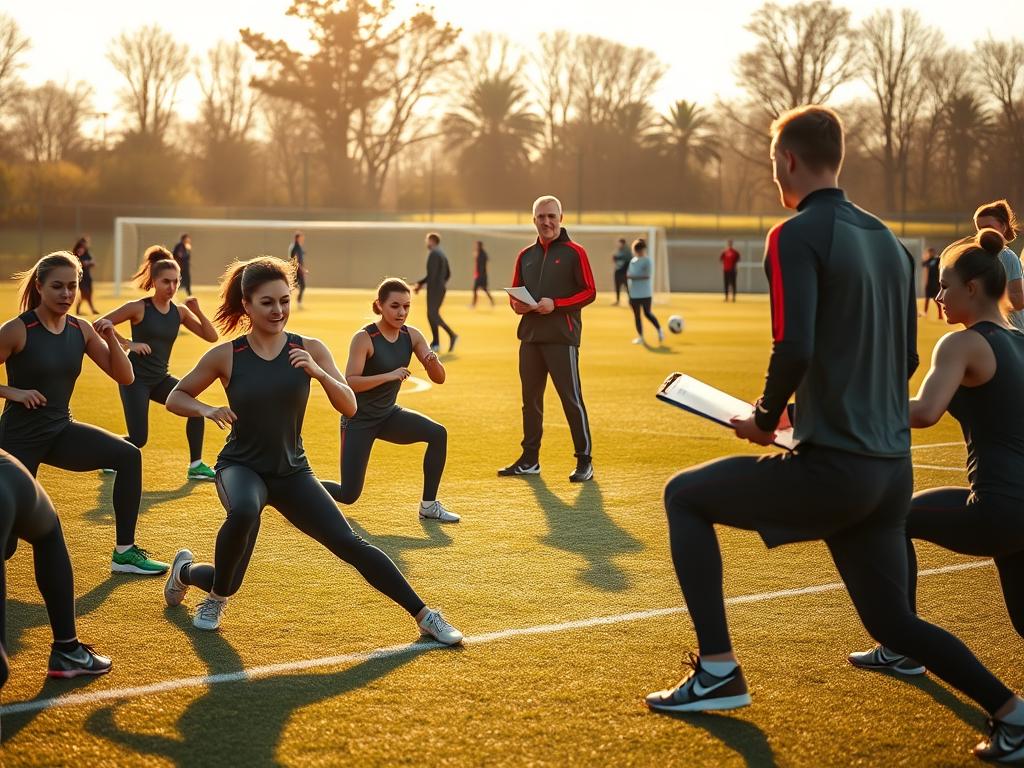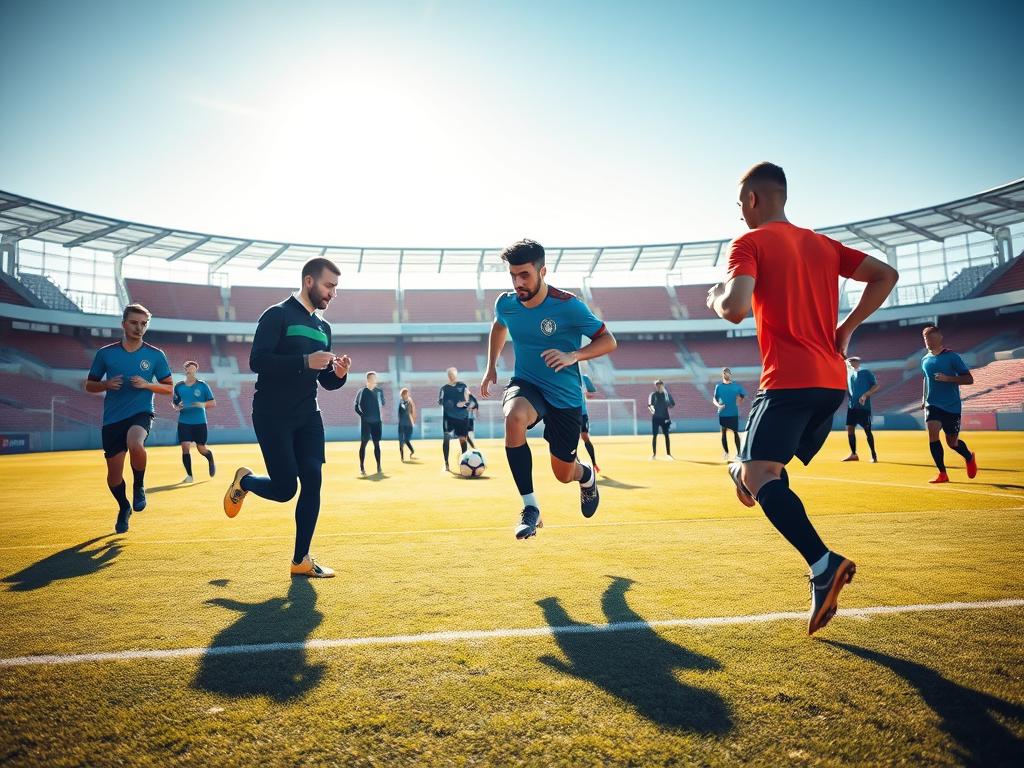Did you know that multi-directional sprints, jumps, and sudden stops during a match raise injury risk and fatigue more than traditional steady running? That single fact explains why smart preparation matters so much.
Want to play harder for 90 minutes and walk off feeling fresh? A well-designed resistance program helps you keep going and lowers season-long injury odds. Thomas Newman at Mass General Brigham finds that greater muscle resilience from a focused plan helps athletes endure the whole match.
This guide shows a simple, time-efficient program you can use twice or thrice weekly. You’ll learn why a clear plan beats random workouts. We map achievable levels, short session flows, and practical cues so you make progress without losing your week to long gym sessions.
Curious how a few big lifts can boost touch, duels, and balance under pressure? Read on and get a practical road map—and check injury prevention tips at prevent and treat soccer injuries.
Key Takeaways
- Match actions drive fatigue and injury risk; targeted work reduces that load.
- Short, focused sessions (2–3 per week) give big returns without wasting time.
- A clear plan beats random workouts; progress from single reps to sets.
- Improved power helps control duels and stability in chaotic moments.
- We’ll provide session order, warm-up cues, and simple metrics to track progress.
Why Strength Matters Now: Performance, Speed, and Lower Injury Risk
Modern match play throws sudden cuts, airborne duels, and quick recoveries at you every minute. Those bursts demand robust force absorption and repeatable speed when fatigue shows up.
The game’s demands are multi‑directional and high‑force. Frequent jumps and hard landings load the body in all planes. Without solid muscle support, the whole body compensates and injury risk rises.
Stronger hips, a sturdy back and a stable trunk help you cut, shield, and win duels with less wasted motion. Want late‑game speed? Good base power keeps your mechanics intact in minute 85.
- Play is stop‑start: lateral, diagonal, then full throttle.
- Better force absorption lowers awkward compensations and overuse injury risk, especially in female athletes.
- Two to three weekly sessions lift performance and reduce season-long risk without crowding out ball work.
In short: build resilient muscles, move well, then move with intent—your skills will last longer on match day.
How to Structure Training Sessions Across the Season
Think of the season as two blocks — a volume phase to build and a maintenance phase to preserve gains. Which block you’re in changes weekly frequency, load, and how you use time.

Weekly frequency and focus
Off‑season: aim for 2–3 sessions per week to teach technique and raise total work. Use two‑arm swings and Zercher squats twice weekly and add brief accessories.
In‑season: drop to one session. Keep it short, high intensity, and sharp so you stay fresh for matches.
Practical session flow and progression
- Warm-up, power swings, main Zercher work, quick accessories, recover — finish under an hour.
- Progress weekly in the off‑season by adding crisp reps or modest load and test a Zercher 5RM in the final build week.
- During matches, alternate kettlebell sizes (16kg/20kg) early in the cycle before moving to the heavier bell for all sets.
- Track levels by session feel and bell speed; if technique drops, reduce the set and come back stronger.
Strength Training for Soccer Players: Core Lifts and Targets
Core lifts act like a roadmap—hit the targets and your game holds up under pressure. Set simple numbers, then build safe reps and sets. Start light and prove control with a clean one rep before you add volume.
Back or Front/Zercher Squat
Aim to squat toward 1–1.75x your body weight. Squats train big lower-body muscles and the trunk. Use front or Zercher variations if mobility limits a back squat.
Deadlifts
Targets: 1.5–2x body weight. Deadlifts build glutes, hamstrings, core, and the back. They teach a powerful hip hinge and protect the posterior chain.
Bench Press
Aim for 0.5–1x body weight. The bench develops the upper body and helps stabilize the shoulder girdle during aerial duels and shielding.
- Clear targets: squat 1–1.75x, deadlift 1.5–2x, bench 0.5–1x.
- Start with one rep done well, then move to 3–5 reps and three sets.
- Keep weight sensible; add small jumps only when technique is crisp.
- Rest between sets to protect bar speed; stop if the last rep turns into a grind.
| Lift | Target (bodyweight) | Main muscles |
|---|---|---|
| Back / Front / Zercher Squat | 1.0–1.75x | Quads, glutes, hip adductors/abductors, trunk |
| Deadlift | 1.5–2.0x | Hamstrings, glutes, core, back |
| Bench Press | 0.5–1.0x | Chest, shoulder girdle, upper back, trunk |
Want practical injury tips that tie into footwear and groin risk? Read about cleats and groin injuries to keep your sessions safe and game-ready.
Power and Posterior Chain: Kettlebell Swings and Zercher Squats
Want more pop on your runs and cleaner decelerations? Focus on ballistic hip work and front‑loaded squats. These two exercises build raw power and a resilient posterior chain while keeping the midsection tight.

Why the two‑arm swing builds hip drive and durability
The two‑arm kettlebell swing loads the hips explosively. It fires the hip extensors, lights up the hamstrings, and forces the trunk and lats to lock the torso. Grip and shoulder endurance get a carryover too.
Zercher squats: a mobility‑friendly quad and trunk emphasis
Holding the load in the crook of the elbows puts the bell in front. That front‑loaded position trains the midsection and quads without demanding deep upper‑back mobility. It sets a safe bridge to the back squat.
Progressing loads while protecting form
- Off‑season: do swings and Zerchers twice weekly and add total weight as proper technique stays sharp. Test a Zercher 5RM in the final build week.
- In‑season: cut to once weekly, raise bell weight, and lower reps to keep movement snappy.
- Rule: push weight only when reps stay explosive. If the back grinds, reset stance and lighten the load.
Single-Leg and Accessory Work to Balance Limbs and Build Upper Body
Targeted single-leg drills level limbs and sharpen late-game mechanics. They fix side-to-side gaps and prime the hips for powerful movement.
Warm-ups used single-leg deadlifts to wake balance and the hip hinge. Sessions ended with loaded Bulgarian split squats and weekly progressions. When athletes hit split squats with a kettlebell at ~1/3 body weight for 2-4-6 x 3 sets, reverse airborne lunges were added.
Unilateral lower-body patterns
- Single-leg deadlifts prime balance and the hinge—perfect before power swings.
- Bulgarian split squats build toward ~1/3 bodyweight, then progress to reverse airborne lunges.
Upper-body pairings and rows
Half-kneeling landmine press teaches the shoulder and trunk to press together. The goal? Clean reps toward 50% body weight.
Bench press used a 5×5 scheme with 3% increases every two sessions. Pull-ups followed StrongFirst Fighter progressions. Single-arm kettlebell rows started supported at ~1/3 body weight, then moved unsupported with a 15% load drop.
Why this mix works: it evens limbs, fires the right muscles to protect hamstrings, and speeds force transfer. Smooth reps matter—stop a set early if form fades and keep the progress steady.
Sets, Reps, and Progression Models You Can Apply Today
A practical progression keeps gains steady and form intact. Start with clear weekly goals, log every session, and check one rep as a readiness marker. If that single looks slow, don’t add load—reset and fix the issue.
Off‑season: build volume and test 5RM
In the build block, increase swing and Zercher volume each week while preserving proper technique. Stack quality sets, not sloppy reps. Finish the cycle with a targeted Zercher 5RM to set new training maxes.
In‑season: lower volume, keep power
Cut to once‑weekly sessions. Use heavier swings with fewer reps. In early weeks alternate bell sizes, then pick the heavier bell for all sets. For Zerchers try a step cycle: start 5×3 at your 5RM, add one rep per set every two weeks until 5×5.
In week six, drop total sets and add 5 kg. Continue that pattern until form fails, then back down and recover.
Simple step cycles and small load jumps
- Begin with 5×3, add reps gradually, then reduce volume and bump load.
- Progress bench by ~3% every two sessions; reset if form degrades.
- Anchor each session with one main lift, one power move, and short accessories.
- Log every set and track goals and performance to decide when to push.
| Phase | Weekly focus | Practical plan |
|---|---|---|
| Off‑season | Volume & control | Increase sets, test Zercher 5RM |
| In‑season | Power & freshness | One session, heavier swings, step cycles |
| Micro‑progress | Small load jumps | ~3% bench increases; use one rep checks |
Keep this rule: when a set loses crispness, stop. Protect bar speed and form, and the program will deliver steady gains.
Safety, Technique, and Session Flow
Start every session by priming single‑leg hinges and short hip swings to wake balance and power. This simple warm‑up sharpens movement and lowers the risk of injury. Keep the warm‑up brief and focused so practice time stays useful.
Warm-up priorities and proper technique cues
Open with single‑leg deadlifts to activate hips and test balance. Add dynamic hip swings and light trunk bracing to set posture.
Lock posture on big lifts: neutral back, firm grip, smooth breath. Emphasize proper technique on swings and Zerchers—progress only while form is clean.
Rest intervals, set management, and avoiding junk volume
- Start sharp: honest rest so each set is crisp.
- Cap total working time—precision beats marathon sessions between matches.
- Keep power movements explosive and strength sets controlled.
- End sets before form breaks to reduce chronic injuries and overuse risk.
- Use small load steps (example: 5 kg on Zerchers) to manage adaptation.
| Item | Purpose | Typical time |
|---|---|---|
| Single‑leg hinge | Activate hips & test balance | 3–5 min |
| Power swings | Train explosive movement | 8–12 min |
| Zercher work | Build quad/trunk control | 10–15 min |
Quick rule: players improve when routines repeat. Same warm‑up, same lift order, tight time boxes, and clear cues protect the back and trunk and keep progression steady.
Put It All Together: A Practical Weekly Plan to Elevate Your Game
Small, smart sessions across a week produce big game-day gains. Off‑season, run two sessions: Session A with single‑leg deadlifts, two‑arm swings, Zercher squats, bench press, and Bulgarian split squats. Session B swaps in pull-ups/rows and a front‑squat or Zercher variation.
In‑season, cut to one tight session. Use heavier swings, lower reps, and a Zercher step cycle (5×3 → 5×5), then reduce volume and add 5 kg in week six. Use one‑rep checks to decide if you add weight or stay put.
Track bar weight and how the body moves. Hit upper‑body work twice in the off‑season and keep short maintenance sets during the season. Do this and you’ll build power, steady movement, and fewer hamstring injuries—better late‑game output awaits!







